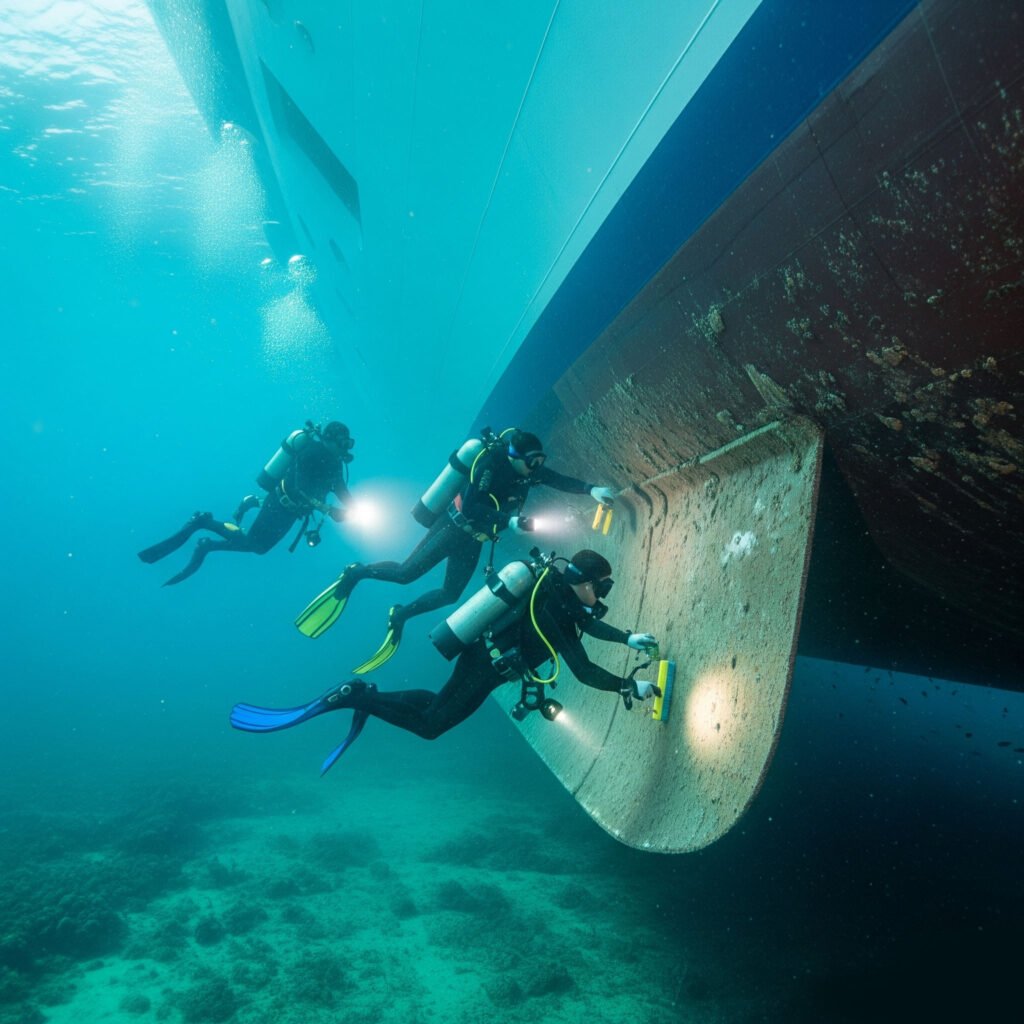Underwater Hull Cleaning in Brazil: Brazil’s thriving maritime sector supports some of the busiest trade routes in South America. With over 7,400 kilometers of coastline, Brazil is home to more than 40 major ports, including the internationally critical Port of Santos, Rio de Janeiro, and Paranaguá. These ports facilitate the movement of goods like iron ore, coffee, soybeans, and oil. But beneath the waves lies a hidden challenge faced by every vessel: biofouling.
Underwater hull cleaning in Brazil has emerged as a vital service to ensure that vessels remain efficient, compliant, and profitable. Let’s dive deep into the science, technology, benefits, challenges, and best practices of underwater hull cleaning in Brazil and why it’s an indispensable maintenance strategy in Brazilian waters.

Understanding Marine Biofouling: The Silent Performance Killer
Marine biofouling is the accumulation of aquatic organisms, such as barnacles, algae, tube worms, and mussels, on the submerged surfaces of a ship’s hull. It begins with a thin slime layer and can develop into heavy macrofouling if not addressed.
Brazil’s warm, nutrient-rich waters accelerate this process. Ports located near estuaries and in tropical zones see biofouling rates 2 to 3 times higher than those in colder waters.
Key impacts of biofouling:
- Up to 40% increase in fuel consumption due to drag
- Slower voyage speeds
- Damage to antifouling coatings
- Increased emissions and a higher carbon footprint
- Spread of invasive marine species
What Is Underwater Hull Cleaning?
Underwater hull cleaning is the process of removing biofouling from a vessel’s hull while the ship remains in the water. This technique eliminates the need to dry-dock the vessel, allowing for continued operation and reduced downtime.
Methods used in underwater hull cleaning in Brazil:
- Manual cleaning by divers using brushes and scrapers
- Mechanical rotating brushes (hydraulic or electric)
- Water jetting at low pressure
- Magnetically attached cleaning robots (ROVs)
- Filtration and suction systems to recover the removed fouling
These methods aim to restore the hull’s smoothness, reduce resistance in water, and ultimately improve fuel efficiency and reduce emissions.
Why Underwater Hull Cleaning Is Crucial in Brazil
Brazil is one of the few countries where ships frequently remain stationary for extended periods due to cargo handling times, port congestion, or offshore operations. These idle periods increase fouling, making the Brazilian coastline a high-risk zone for marine growth.
Major zones affected by marine growth:
- Amazon River Estuary: High in nutrients and freshwater organisms
- Port of Suape: Close to oil platforms and deep-sea routes
- Port of Manaus: Inland port with warm, slow-moving waters
Benefits of Underwater Hull Cleaning in Brazil
✅ Enhanced Fuel Efficiency
Biofouling increases hydrodynamic drag, forcing engines to work harder. Clean hulls can reduce fuel usage by up to 15–25%, depending on fouling severity.
✅ Improved Voyage Speed
A clean hull minimizes friction and allows vessels to maintain optimal speed without overworking engines, improving ETA accuracy.
✅ Lower Operational Costs
Reduced fuel burn and less wear on propulsion systems result in lower maintenance and operating expenses.
✅ Compliance with IMO & Environmental Standards
Brazil adheres to the IMO’s Biofouling Management Guidelines, and hull cleaning helps maintain a ship’s Energy Efficiency Existing Ship Index (EEXI) score.
✅ Minimized Risk of Invasive Species Transfer
Frequent cleaning and use of proper filtration systems prevent ships from introducing non-native organisms into other ecosystems, a major environmental concern.
How the Process Works: Step-by-Step Hull Cleaning in Brazil
Here’s what typically happens during a professional hull cleaning operation in a Brazilian port:
- Initial Hull Inspection
Divers or underwater drones perform a visual inspection using HD cameras to assess fouling levels. - Customized Cleaning Strategy
Based on hull condition, vessel type, and coating, a tailored cleaning plan is created. - Deployment of Tools
Depending on severity and depth, divers or ROVs equipped with rotating brushes, suction heads, and filtration units begin cleaning. - Real-Time Monitoring
Supervisors monitor video feeds and guide divers remotely to ensure complete coverage. - Waste Recovery and Filtration
Removed fouling is collected using vacuum systems, filtered onboard, and disposed of per IBAMA guidelines. - Post-Cleaning Inspection & Documentation
Final video footage is shared with the shipowner or operator for record-keeping and compliance verification.
Compliance and Environmental Regulations in Brazil
Due to the risk of contamination and ecosystem disruption, underwater hull cleaning is tightly regulated by Brazilian maritime and environmental agencies.
Key regulatory bodies:
- IBAMA – Oversees environmental impact and permits
- ANVISA – Ensures vessels entering Brazilian waters meet sanitation standards
- IMO – Sets international compliance frameworks
Important regulations:
- Cleaning must occur in designated zones
- Ships must use biocide-free antifouling coatings if possible
- Waste must be filtered, documented, and safely disposed
- ROV or diver-based inspections are mandatory before and after cleaning
Non-compliance can lead to heavy fines, denial of port entry, or vessel quarantine.
Cost of Underwater Hull Cleaning in Brazil
Pricing for hull cleaning in Brazil can vary based on:
- Vessel size and draft
- Port location and depth
- Fouling severity
- Type of antifouling coating
- Level of environmental compliance required
Frequency: How Often Should You Clean Your Hull in Brazil?
Regular maintenance is essential to avoid excessive fouling and performance drop. Frequency depends on:
- Type of antifouling coating used
- Time spent stationary in port
- Water temperature and salinity
- Voyage frequency and destination
The Future of Hull Maintenance in Brazil
As the maritime industry shifts toward sustainability and digitalization, Brazil is witnessing the adoption of smart hull-cleaning technologies.
Emerging trends include:
- AI-driven hull monitoring platforms
- Autonomous underwater robots (eco-ROVs) for hands-free cleaning
- Big data analytics for predicting fouling zones and fuel savings
- Cloud-based fleet management tools for maintenance scheduling
Top Brazilian ports are collaborating with international tech companies to create Green Ship Corridors, where hull cleaning, emissions tracking, and waste recovery are all digitally integrated.
Conclusion: A Clean Hull Is a Smart Investment
Underwater hull cleaning in Brazil is more than a maintenance task—it’s a vital investment in operational efficiency, environmental responsibility, and regulatory compliance. In a region where biofouling can form rapidly due to tropical waters, maintaining a clean hull ensures that your vessel remains fuel-efficient, fast, and cost-effective.
To achieve the best results, it’s essential to partner with professional and certified service providers. One such trusted name in the industry is CleanShip. CleanShip offers cutting-edge underwater hull cleaning and maintenance solutions that adhere to strict environmental standards and deliver measurable fuel and cost savings. Their use of advanced equipment, diver expertise, and eco-friendly waste recovery systems makes them an ideal partner for vessels navigating Brazil’s dynamic maritime environment.
FAQs:
1. What are the most common methods used in underwater hull cleaning?
Common methods include:
Manual brushing by divers
Mechanical rotating brushes
Low-pressure water jetting
Magnetically-attached cleaning robots (ROVs)
Suction and filtration systems
2. Does underwater hull cleaning in Brazil require dry-docking the ship?
No. That’s one of the major advantages. The ship remains operational, and there’s no need to bring it into dry dock, which saves time and money.
3. Is underwater hull cleaning environmentally friendly?
Modern cleaning systems often include filtration and collection units that prevent biofouling from dispersing into the ocean, helping meet environmental and port regulations.
4. Who performs underwater hull cleaning in Brazil?
Specialized marine service companies or certified divers typically perform the cleaning, using professional equipment designed for various types of hull surfaces.
5. Can hull cleaning improve a ship’s speed?
Yes. A clean hull reduces resistance in the water, which can improve a ship’s speed and maneuverability, especially for high-performance or commercial vessels.


